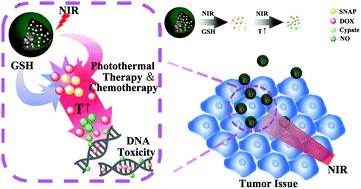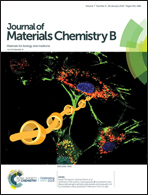Near-infrared light-mediated and nitric oxide-supplied nanospheres for enhanced synergistic thermo-chemotherapy†
Abstract
Synergistic thermo-chemotherapy based multiple stimuli-responsive drug delivery systems have achieved significant improvement of cancer curative effects compared with single modality treatment. Nevertheless, the efficacy of thermo-chemotherapy is often reduced in drug-resistant tumors and the therapy method is unexpectedly associated with potential toxicity by utilizing poorly degradable materials. Here, we report a simple approach to encapsulate three drug payloads into multi-sensitive and degradable nanospheres (SDC@NS) to achieve anticancer effects. SDC@NS comprise a photothermal agent (cypate), an anticancer agent (doxorubicin), and a nitric oxide donor (SNAP) to achieve controllable drugs release in high concentration glutathione or under near-infrared light (NIR) irradiation. Hyperthermia from NIR-mediated cypate can accelerate cancer cell apoptosis in vitro and tumor tissue ablation in vivo. Furthermore, our results also confirmed that the nitric oxide-based SDC@NS showed significant cytotoxicity compared to the nitric oxide absent group (denoted as DC@NS) and an enhanced chemotherapy effect in vivo. The photothermal effect and payloads can synchronously realize cancer therapy and provide a new insight into the enhanced synergistic therapeutic effect.



 Please wait while we load your content...
Please wait while we load your content...